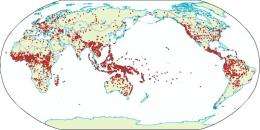Dating the world's language families

(�鶹��ԺOrg.com) -- A computerized method for determining when prehistoric languages were spoken has been developed by an international group of scholars known as the ASJP (Automated Similarity Judgment Program) consortium. ASJP is anchored in the Linguistics Department of the Max Planck Institute for Evolutionary Anthropology in Leipzig, Germany.
The method is described in the most recent issue of Current Anthropology.
The new method, building on an earlier approach known as glottochronology, calculates dates for parent languages of all of the world’s language families including such groups as Indo-European, Austronesian, and Mayan. It is based on the observation that the greater the linguistic differentiation within a family, the greater the period of time required for that differentiation to accrue. By quantifying vocabulary differences across languages of a family, the date at which a family’s parent language was most recently spoken is determined.
The database used, compiled over several years by the ASJP consortium, is of unprecedented size, covering over half of the world’s more than 6000 languages. “ASJP dates facilitate connecting languages of the remote past with events revealed through archaeology, thus enhancing the study of prehistoric peoples”, says Søren Wichmann, a researcher at the MPI for Evolutionary Anthropology.
More information: Eric W. Holman, et al. Automated Dating of the World’s Language Families based on Lexical Similarity, Current Anthropology, December 1, 2011
Provided by Max-Planck-Gesellschaft

















